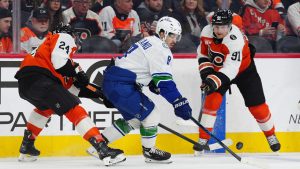Has the NHL pre-season jumped the shark?
In exhibition play so far we have seen serious injuries to Patrik Laine, Drew Doughty and David Reinbacher, among others, and had a multitude of NHL stars held out of games or leaving early for precaution.
Last Saturday night we saw a roster of mostly Toronto Marlies play against essentially the opening night lineup for the Canadiens -- three hours later two Canadiens left the Bell Centre on crutches. A few nights earlier at Scotiabank Arena, Toronto dressed over $60 million in player salaries against a version of the Belleville Senators.
It's not like these examples of two wildly different lineups going against each other are relegated to just Canada either. It's a league-wide issue. Just this week we’ve seen the NHL Devils get ready for their regular season to begun in Europe while the AHL Utica Comets played a back-to-back against the New York Rangers. New York's Artemi Panarin left one of those contests for precautionary reasons.
With the way this year’s pre-season has gone, many fans (and those in management and coaching) have been left to question whether it’s time for a bigger change in how the league approaches this time on the calendar. Is shortening the pre-season schedule the only solution that's needed, or are there other ideas to consider?
Before we can get into ways to improve the current situation, we need to understand how teams handle the period between training camp and the start of the regular season.
SEGMENT 1: TRAINING CAMP (3-4 Days)
Players in Camp: 60-plus
Purpose: Set the foundation and tone for the season
Roster Construction: Split across three "teams"
Length of Schedule: 2-3 split squads
SEGMENT 2: PRE-SEASON WEEK 1
Players in Camp: 40-plus
Purpose: Get reps, players start to play in 'NHL games'
Roster Construction: Usually split between two even groups
Length of Schedule: 3-4 Games
This is where the biggest issues have come this year, with teams more often dressing an NHL lineup at home and an AHL lineup on the road. Current roster rules allow this and we saw a huge discrepancy between teams and players on the ice (ECHL-AHL-NHL Star).
SEGMENT 3: PRE-SEASON WEEK 2
Players in Camp: Around 36
Purpose: Preparing players for the first game of the NHL season
Roster Construction: Split into NHL and AHL groups
Length of Schedule: 3-4 Games
By now the pre-season starts to drag on and players who have no realistic chance to make the NHL club are still in town to play a meaningless pre-season game that management doesn’t put any real weight into.
HOW WE GOT HERE
In the past teams there were two main reasons to have training camp and pre-season games.
1. Get players back in shape: This isn’t the 1972 Summit Series anymore. Players come to town out of summer in the best shape of their lives and are physically ready to compete. They do need a few games to get back up to NHL pace, but for this to be effective the competition and their teammates need to actually be NHL players.
2. Evaluate players teams aren’t as familiar with: The GM of an NHL team in the 1980s may have rarely, if ever, seen a certain player under contract play hockey. Now with video scouting and analytics, managers can see every shift and have every piece of data they would ever need on any player. The need today is to evaluate players as they seek to switch between levels: can an AHL player keep pace in the NHL?
I look at a situation like Max Pacioretty. Sure, he scored two goals in his first pre-season tryout game, which should be enough. But he was playing on a stacked Maple Leafs lineup against players who largely won't make the NHL, so what did we really learn? Teams need to trust their gut, use scouting, video and analytics to sign whoever they target and keep pre-season decisions down to six players or so -- and not 20.
WHAT CAN WE DO TO FIX THE NHL'S PRE-SEASON?
Shorten the whole preparation window: This isn't a new idea, and it seems to be a discussion point for the next CBA, but the pre-season needs to be more compact. Currently training camp and pre-season lasts around 19 days (plus about another three or four days until the first game of the regular season).
Instead, start training camp on a Monday, with pre-season games beginning on the Friday. Owners could still get two weekends worth of games to sell. Then drop the puck on the regular season the following Tuesday/Wednesday. This would shorten the pre-season window from 20-21 days to 14-15 days between the opening of camp and the start of the season.
Reduce the number of exhibition games: This one is a bit trickier. Teams like making money, and home games generate money. Realistically, though, teams should only play four or five pre-season games to keep competition high, and to reduce the chance for injuries in games that mean nothing or serve no purpose.
So, the solution to the money question is simply to add two more regular season games and make it an 84-game schedule. With considered for hockey-related revenues, both players and owners should be able to walk away happy.
This would have to be a collectively bargained issue, since it's covered in this clause of the CBA:
“15.4 (b) Each Club shall schedule no less than six (6) and no more than eight (8) Exhibition Games during Training Camp.”
The current NHL/NHLPA CBA runs through the 2025-26 season, so this change couldn't be applied next year.
Changing rules for who can dress in pre-season games: Reducing the number of pre-season games will help decrease the chance of injury, though it's a risk that can never be completely removed. One bigger concern is how some of the injuries we've seen to NHLers have come from run-ins with players who won't be cracking an NHL lineup.
Also, if teams are trying to measure who should win a roster battle, which prospects are ready for regular season action, or just want to get their core up to NHL speed, it'd be better to also change rules that would force teams to dress stronger lineups through a reduced pre-season schedule.
This is another collectively bargained issue. Too many pre-season games are watered down, with teams dressing strong lineups at home and far weaker ones on the road. The current CBA enforces these rules for pre-season lineups:
“15.4 (c) A Club shall be permitted to dress a minimum of eight (8) veterans for any Exhibition Game.
For purposes of this Section 15.4(c), a veteran shall constitute either:
(1) a forward or defenseman who played in thirty (30) NHL Games during the previous season,
(2) a goaltender who either dressed in fifty (50) or more NHL Games or played in thirty (30) or more NHL Games in the previous season,
(3) a first round draft choice from the most recent year's Entry Draft, or
(4) any Player who has played one-hundred (100) or more career NHL Games.”
As written, this rule still allows too much leeway for weak lineups. For instance, in Toronto's lineup last Saturday, the eight players who qualified as veterans were Pontus Holmberg, Matthew Knies, Stephen Lorentz, Simon Benoit, Nick Robertson, Alex Nylander, Logan Shaw, and Philippe Myers.
At most, five of those players could be in their opening night lineup, and possibly only four.
Along with a reduced pre-season schedule, the NHL will need to fine-tune the lineup rules to ensure the majority of players in a game are truly NHL players. Some ideas to accomplish this include:
• Changing the threshold of 30 games played the previous season to 50.
• Changing the 100 career games threshold to 200.
• Eliminating the first-rounder rule.
• Increase the required amount of dressed veterans from eight to 12.
With this setup, you'd still realistically be able to rest one full line of your regular season lineup each game, making room for players on PTOs or prospects to get their chance to show something.
The majority of the analysis on players should be done before training camp even starts anyway, and teams should be wary of drawing conclusions based on small sample sizes.
Let's be honest: if you were truly trying to make a decision on whether or not to sign someone like Pacioretty to a standard contract, wouldn't you rather see him compete in tougher situations, against true NHLers?
Any time something changes, there will be unexpected consequences. But as we see more players getting hurt in the 2024 pre-season, and weaker lineups being iced against much stronger ones, it’s necessary to consider how to evolve the NHL's pre-season and to resolve it in the next CBA.



 4:46
4:46

